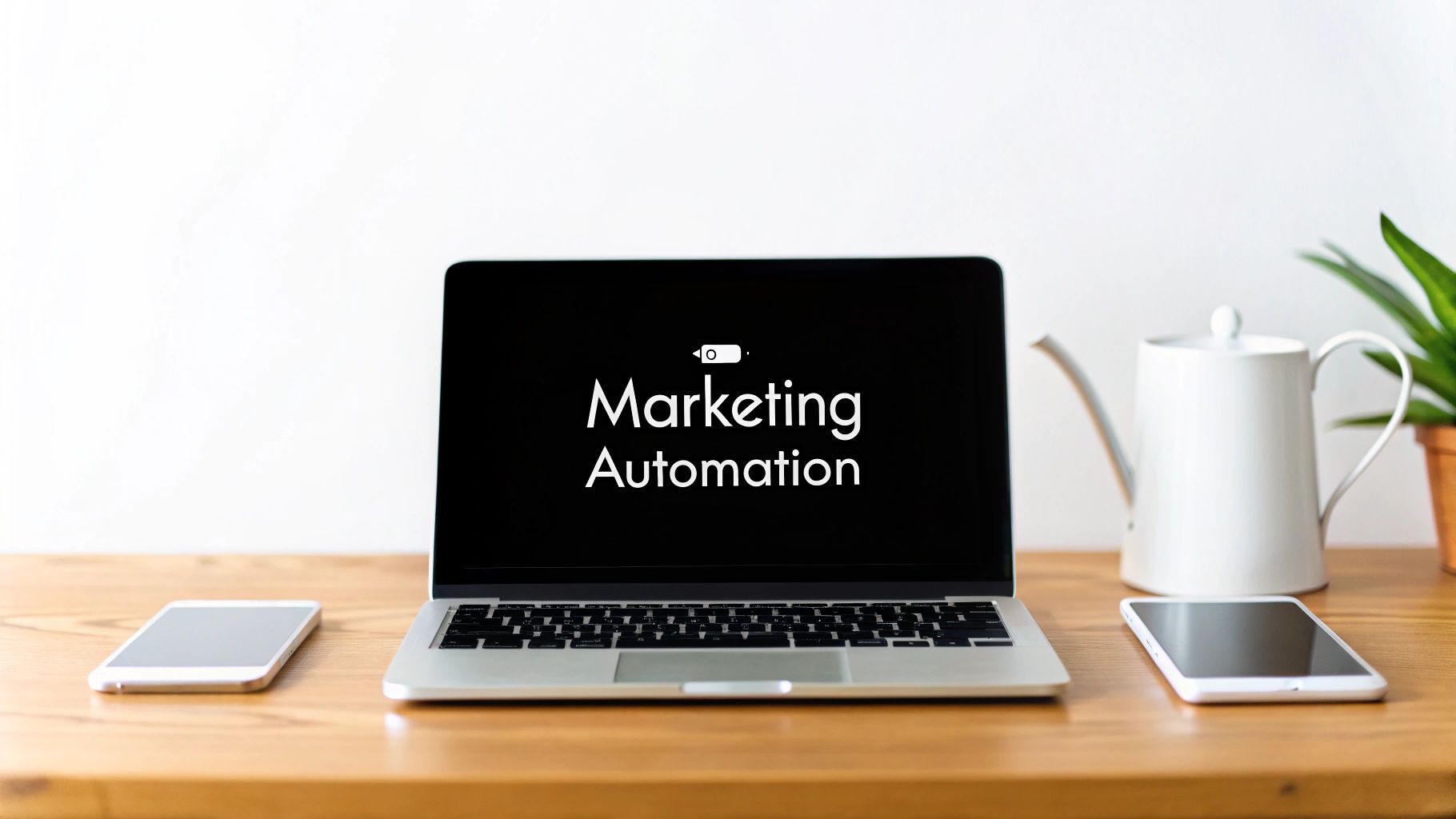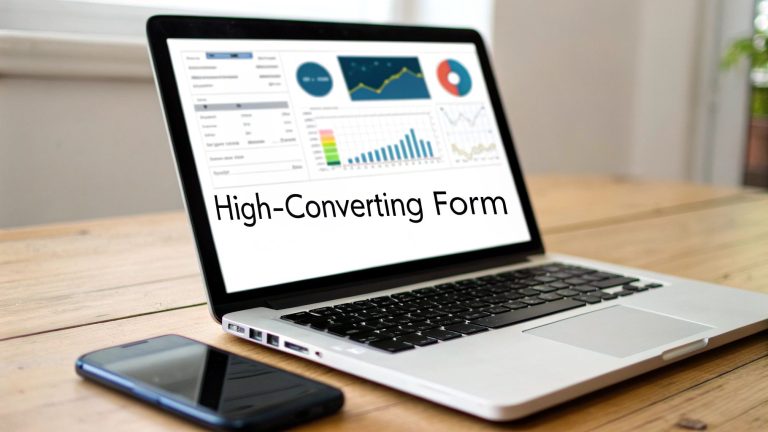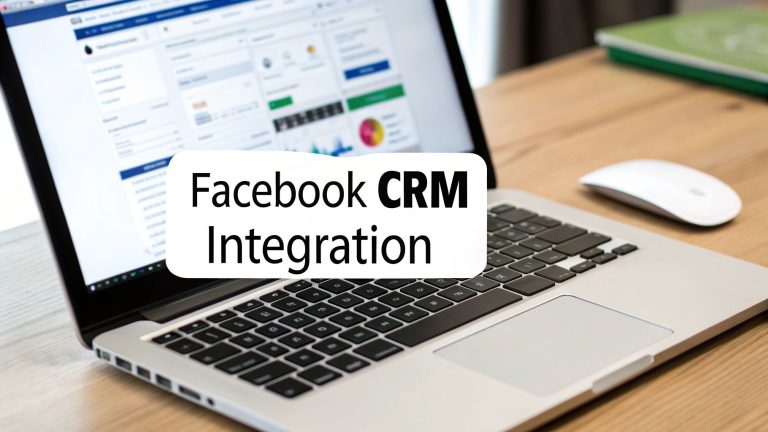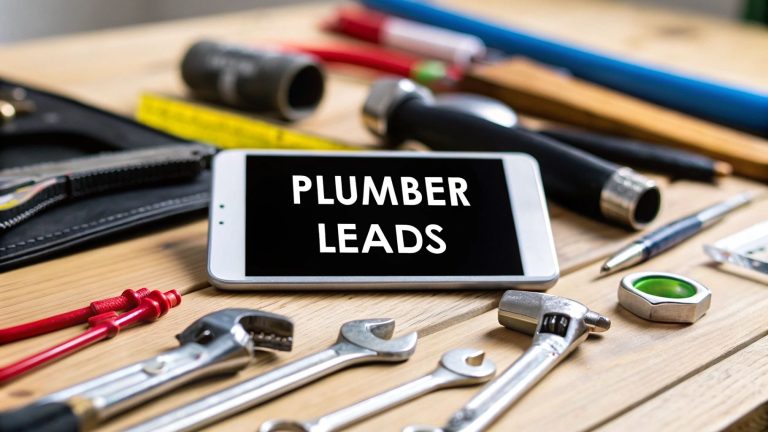Marketing Automation for Small Businesses Explained
Picture this: your marketing is humming along 24/7, engaging potential customers and nurturing leads, all while you’re focused on running your actual business. This isn’t some far-off fantasy for giant corporations anymore. Marketing automation for small businesses is here, and it's a total game-changer. It's all about swapping out those repetitive, manual marketing chores for smart software that works for you on autopilot.
Putting Your Marketing on Autopilot

Think of marketing automation like a smart sprinkler system for your leads. You could run around with a watering can, trying to give every single plant (or lead) individual attention. Or, you could set up an automated system that delivers exactly the right message at exactly the right time, helping everything grow.
This idea has completely leveled the playing field for small businesses. Not long ago, this kind of sophisticated marketing was way too expensive and complex for anyone but the big players. Now, user-friendly tools have made it accessible to everyone. A solopreneur can now operate with the efficiency of a much larger marketing team.
From Manual Effort to Automated Success
The core concept is brilliantly simple: pinpoint the repetitive, soul-crushing tasks in your marketing and sales process, and let technology take over. This frees you and your team to focus on the things that actually move the needle—strategy, creative ideas, and building real relationships with customers.
To get it right, it helps to understand the foundational principles. Brushing up on marketing automation best practices is a great first step to ensure you're building a strategy that will actually work from day one.
Let's be real, every small business owner feels these pain points:
- Chasing every new lead: Manually sending welcome emails and follow-ups is a huge time-sink and it's easy for things to fall through the cracks.
- Trying to remember who to email: Keeping your audience engaged with regular, valuable content requires a ton of mental energy and organization.
- Guessing what customers want: Without a system, it's nearly impossible to track who's interested in which products or services.
Marketing automation tackles these head-on by creating simple "if-this-then-that" rules. For instance, if someone downloads your latest guide, then the system automatically sends a thank-you email, followed by a series of helpful, related emails over the next few weeks.
Key Takeaway: The goal isn't to get rid of the human touch. It's to supercharge it. Automation handles the grunt work so you can have more meaningful conversations with people who are already warmed up and ready to talk.
To see this shift in action, check out the table below. And when you're ready to build your own system, our guide to a successful marketing automation implementation offers a clear, step-by-step roadmap. (https://leadsavvy.pro/post/marketing-automation-implementation/)
Marketing Automation at a Glance for SMBs
Here's a quick breakdown of how automation transforms everyday marketing tasks, giving small businesses a serious competitive edge.
| Manual Task | Automated Solution | Key Small Business Benefit |
|---|---|---|
| Manually sending welcome emails | An automated welcome series for new subscribers | Ensures immediate, consistent engagement |
| Forgetting to follow up with cold leads | A lead nurturing workflow that re-engages contacts | Recovers lost opportunities without manual effort |
| Sending the same newsletter to everyone | Segmented campaigns based on user behavior | Delivers more relevant content, boosting open rates |
| Updating CRM contacts by hand after a sign-up | Instant data sync between your forms and your CRM | Saves time and eliminates critical data entry errors |
By making these simple swaps, you reclaim countless hours and create a far more effective and personalized experience for your customers. It's about working smarter, not harder.
How Automation Fuels Small Business Growth

So, we know what marketing automation is, but what does it actually do for a small business? This is where the magic happens. It’s not just about being more efficient; it’s about unlocking growth that would otherwise be impossible with a small team and a tight budget.
Think of it as the ultimate way to punch above your weight.
The real advantages break down into three game-changing pillars. First, you get your most valuable resource back: time. Second, you start bringing in better leads, and more of them. And finally, you can give customers a personalized experience that makes them feel valued—all without hiring a massive team.
Reclaim Your Most Valuable Asset: Time
If you’re a small business owner, you know the feeling of being stretched thin. You’re bogged down by repetitive tasks like sending follow-up emails, updating contact lists, or posting to social media. These chores can eat up your entire day, leaving zero room for big-picture strategy.
This is where marketing automation steps in to act as your tireless assistant. It handles all the boring, rule-based tasks that drain your energy. For instance, when a new lead signs up for your newsletter, the system instantly sends them a welcome email. You don’t lift a finger.
This shift is huge. By automating the routine stuff, you free up your team’s brainpower to focus on what humans do best: building real relationships, coming up with new ideas, and actually steering the business forward. It’s the difference between working in your business and working on your business.
That extra time goes straight back into building a more strategic, agile operation. You can finally get to that new product idea, map out a better customer service process, or just think about your long-term goals.
Generate Higher-Quality Leads
Getting leads is only half the battle. Turning them into paying customers is what really counts. Marketing automation gives you the tools to guide prospects from their first flicker of interest all the way to a sale, with surgical precision. It does this with smart workflows that send the right message at the right time.
Let’s say a visitor downloads a guide from your website. Without automation, that lead might just sit in a spreadsheet, getting colder by the minute. With automation, a pre-built sequence kicks off immediately. The system sends a thank-you email, then follows up with a series of helpful, related articles over the next few weeks.
This process is called lead nurturing, and it’s all about building trust and keeping your brand top-of-mind. It educates your prospects, answers their questions, and gently guides them toward your solution. The result? A pipeline full of warmer, more qualified leads who are actually ready to talk to your sales team.
Deliver Personalized Customer Experiences at Scale
Today's customers expect to be treated like individuals, not just another number on a mailing list. They want you to understand them. But for a small team, trying to manually tailor your communication for hundreds or thousands of contacts is a non-starter.
Automation makes this kind of personalization not just possible, but easy. By tracking what people do—like which pages they visit, what emails they open, or the links they click—the system can group your audience into super-specific segments.
This means you can send targeted messages that actually resonate.
- For an e-commerce shop: Automatically send a reminder (and maybe a small discount) to anyone who left items in their shopping cart.
- For a service-based business: Trigger a follow-up email with a relevant case study to a prospect who spent time looking at a specific service page.
- For any business: Send an automated birthday message with a special offer to build loyalty and make customers feel special.
This targeted approach dramatically boosts engagement and conversions. It also shows a clear return on your investment. In fact, marketing automation delivers an impressive revenue return of $5.44 for every $1 spent. That kind of efficiency comes from turning repetitive chores into strategic advantages, freeing up your team to focus on pure growth. You can dive deeper into these figures and other marketing automation trends on SuperAGI.com.
Must-Have Features in Your First Automation Tool
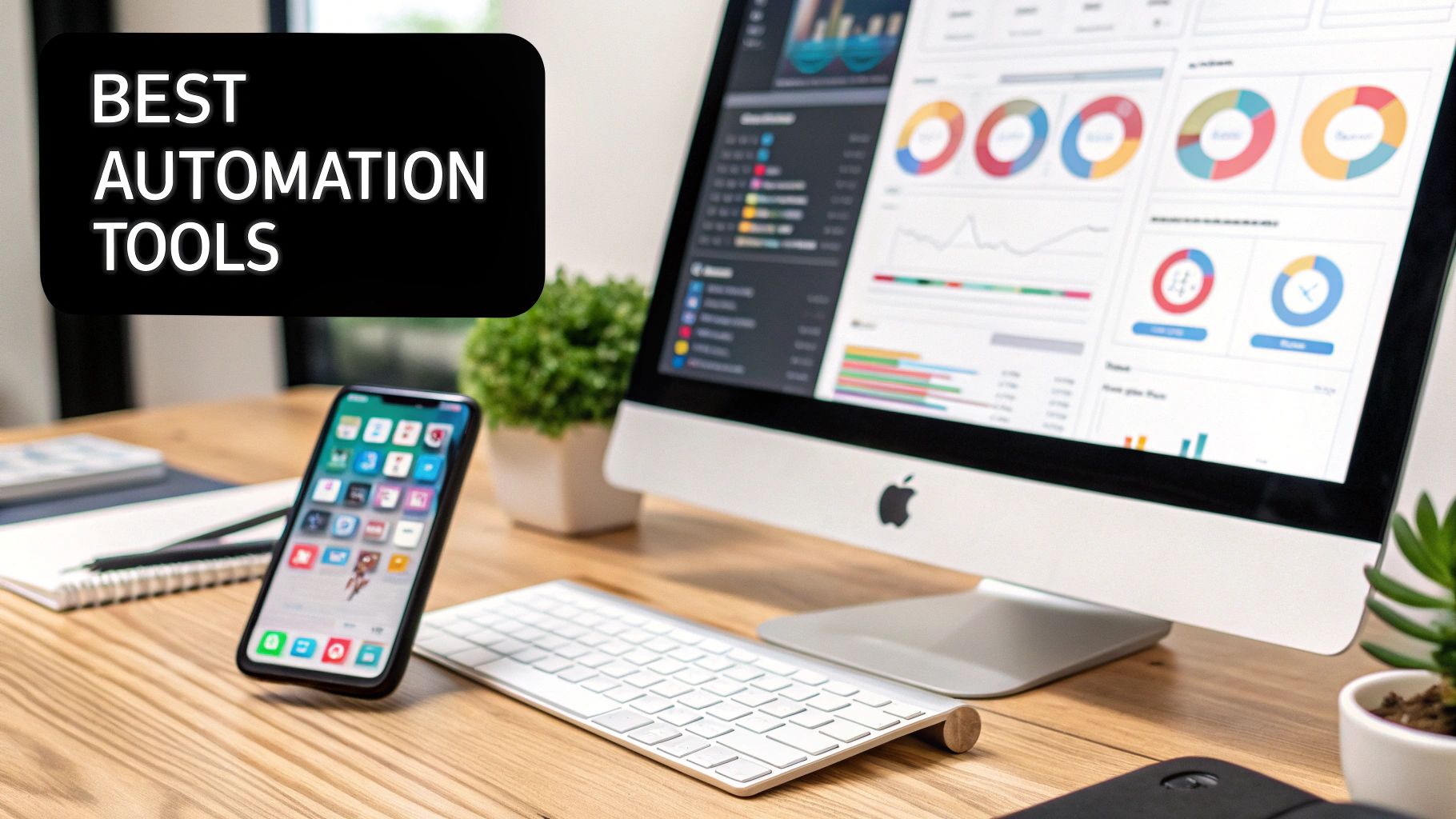
Jumping into marketing automation feels a lot like walking into a massive electronics store. You’re hit with flashy displays and a dozen salespeople talking about features you’ve never heard of. It’s easy to get overwhelmed.
For a small business, the secret is to tune out the noise. Don't get distracted by the most complex, expensive gadget on the shelf. You need to focus on the core functions that will actually make a difference from day one.
Your first platform should be a powerful but simple engine—not a complicated spaceship you don’t know how to fly. Let's break down the non-negotiables.
Automated Email Workflows
This is the heart and soul of marketing automation. Instead of blasting out one-off emails, workflows let you build automated sequences that trigger based on what a customer does. This is how you put lead nurturing on autopilot.
Think of it as a digital employee who never sleeps, gets sick, or takes a vacation. Someone signs up for your newsletter? The system automatically sends your pre-written welcome series. A customer leaves items in their cart? A gentle reminder email goes out a few hours later without you lifting a finger.
Your first tool must have a simple, visual workflow builder. You should be able to easily map out sequences for things like:
- Welcome Series: To greet new subscribers and make a great first impression.
- Lead Nurturing: To guide people who downloaded a resource toward a sale.
- Abandoned Cart Reminders: To recover lost sales with a timely nudge.
These aren't just fancy tricks; they're revenue-generating machines. In fact, nurtured leads make 47% larger purchases than those who aren't nurtured.
Simple Lead Capture Forms
Your automation engine is useless if you don't have any fuel—and in this case, the fuel is leads. That’s why your tool needs to have simple, integrated lead capture forms. You need an easy way to build and embed forms on your website to collect contact info.
This should be dead simple. Look for a drag-and-drop form builder that doesn't require a single line of code. Critically, these forms must connect directly to your contact database, so every new lead is automatically added and ready for your workflows.
Why this matters: Without this, you’re stuck manually downloading spreadsheets and uploading them to your email list. That's the exact kind of soul-crushing admin work that marketing automation for small businesses is supposed to eliminate.
Integrated Contact Management
You need one central place to see and organize all your customer data. While a full-blown Customer Relationship Management (CRM) system might be overkill when you're starting out, your automation tool should have a lightweight, built-in version.
This gives you a complete picture of every single contact. You can see who they are, which emails they've opened, what links they’ve clicked, and what forms they've filled out. That context is pure gold.
This also powers segmentation. You can create smart lists based on behavior—like a list of everyone who clicked on a link about a specific service—and send them a hyper-relevant offer instead of a generic blast.
Easy-to-Read Analytics and Reporting
You can't improve what you don't measure. A good platform will give you clear, easy-to-digest reports that show you what’s working and what’s falling flat. You shouldn't need a data science degree to figure it out.
Look for a clean dashboard that tracks the essentials at a glance:
- Email Open Rates: Are people opening your emails?
- Click-Through Rates (CTR): Are they clicking your links?
- Conversion Rates: Are they taking the action you want them to take?
- Workflow Performance: Which of your automated sequences are actually driving results?
This data helps you make smarter decisions. For instance, a platform like LeadSavvy Pro gives you real-time data to help you tweak your campaigns on the fly, making sure your marketing budget is always working as hard as possible. These four features are the foundation of a solid automation strategy and will help you grow your business without the headache.
Choosing the Right Automation Platform for Your Business
Picking the right marketing automation platform is a make-or-break moment for a small business. Think of it less like buying software and more like hiring a partner for your growth. The right tool saves you time, drives revenue, and grows alongside you. The wrong one? Just a headache and a wasted budget.
It’s easy to get lost in a sea of technical jargon and flashy features you'll never use. To cut through the noise, let's focus on four core things that actually matter. These will help you make a smart, practical decision that fits your business like a glove.
Just look at the impact a good system can have on the numbers.
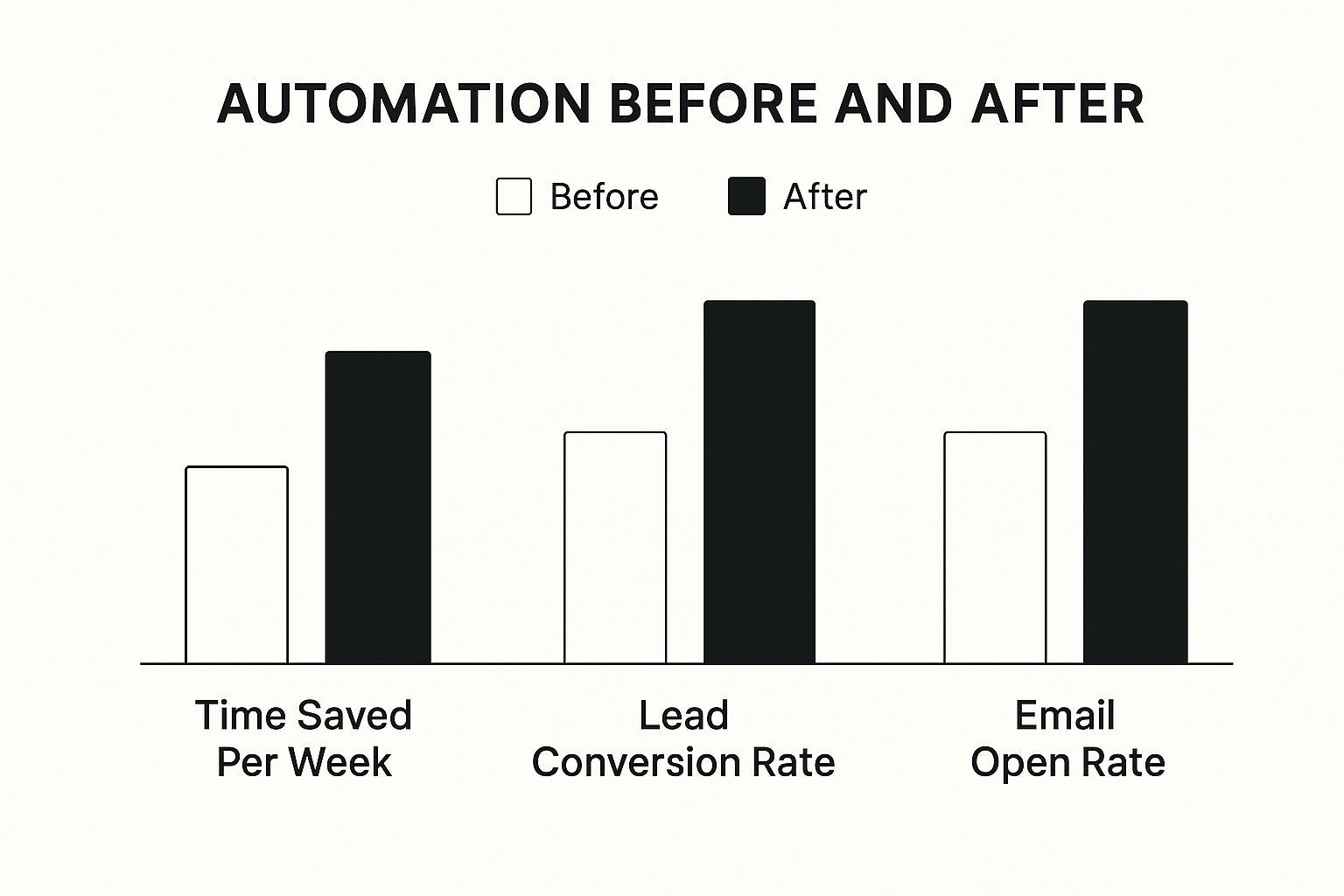
As you can see, this isn't about small tweaks. The right automation delivers huge gains in how efficiently you work, how many leads you convert, and how well you connect with your audience.
Evaluating Your Budget and True Cost
The price tag is just the start. Many platforms lure you in with a low monthly fee, but the costs can skyrocket as your contact list grows. You have to look beyond that initial number and dig into the hidden costs.
- Onboarding Fees: Is there a big, one-time fee just to get set up?
- Contact Tiers: What happens to the price when you hit 1,000, 5,000, or 10,000 contacts? Will you get penalized for growing?
- Feature Gates: Are the features you actually need, like advanced workflows, locked behind a pricey "enterprise" plan?
A tool that looks like a bargain today can quickly become a massive expense. Stick with platforms that offer clear, straightforward pricing that won't punish you for being successful.
Prioritizing Ease of Use
As a small business owner, your time is your most valuable asset. A complicated platform with a steep learning curve can suck up months of your time before you ever see a return. The best marketing automation for small businesses is intuitive and built for people who aren't developers.
You want a tool with a clean dashboard, drag-and-drop builders, and navigation that just makes sense. A platform like LeadSavvy Pro, for instance, was designed from the ground up for small businesses. It focuses on a user-friendly experience so you can get your first campaigns running in hours, not weeks.
Planning for Future Scalability
Where do you want your business to be in a year? Five years? The platform you choose today needs to be able to keep up. A simple email tool might be fine for your first 500 subscribers, but it will fall apart when you need complex segmentation for 10,000 contacts.
Think about your long-term goals. Does the platform have advanced features you can grow into later on? A truly scalable tool gives you what you need for tomorrow without overwhelming you today. This is a critical factor when looking at different marketing automation tools for small business.
Checking for Essential Integrations
Your automation tool can't live on an island. It has to talk to all the other software you rely on—your website, your e-commerce platform, and your sales tools.
Before you sign anything, make a list of your must-have integrations. A platform that connects easily with your existing tech saves you from the nightmare of manually exporting and importing data. It ensures everything stays in sync automatically.
Choosing the right tool ultimately comes down to finding that sweet spot between power and simplicity. It's worth getting right, especially since email remains the most profitable channel for automation. The top 10% of automated email campaigns bring in an average of $16.96 per recipient—crushing the $1.94 from standard campaigns. That stat alone shows how a well-chosen tool can directly fatten your bottom line.
Comparing Automation Platforms for SMB Needs
To help you visualize the trade-offs, here’s a quick comparison of the different types of tools you’ll encounter.
| Consideration | Basic Email Tool | All-in-One Platform | SMB-Focused Tool (e.g., LeadSavvy Pro) |
|---|---|---|---|
| Price | Low entry cost, but scales poorly. | High monthly fees, often with hidden costs. | Affordable, transparent pricing designed for growth. |
| Ease of Use | Very simple, but limited. | Steep learning curve; requires dedicated staff. | Intuitive and user-friendly; launch in hours. |
| Features | Basic email sending and lists. | Overwhelming; too many features for an SMB. | Core features you actually need, without the bloat. |
| Integrations | Limited, basic connections. | Extensive, but can be complex to set up. | Key integrations for SMBs (website, sales tools). |
| Support | Minimal; often self-serve only. | Slow, tiered support unless you pay extra. | Hands-on, personalized support for small teams. |
This table should make it clear that while big, all-in-one platforms have their place, a tool built specifically for small businesses often provides the best balance of power, price, and usability.
Launching Your First High-Impact Automation Campaigns
Alright, you've got the basics down and you've picked your platform. Now for the fun part—launching your first campaigns. The biggest mistake businesses make with marketing automation is trying to do everything at once. Don't try to boil the ocean.
Think of it like learning to cook. You wouldn't tackle a five-course meal on day one. You'd start with a few simple, knockout recipes. These first few campaigns are your foundational recipes for growth, designed to engage customers at just the right moment.
We're going to focus on three essential automations every small business should set up right away. They’re quick to build but pack a serious punch when it comes to building relationships and driving sales.
Campaign 1: The Welcome Email Series
Your first campaign should be a warm handshake for every new subscriber. A welcome series is an automated sequence of emails that fires off the moment someone joins your list or creates an account. This is your best shot at making a great first impression while they’re most interested.
The goal is simple: build instant rapport and guide them to the next step. One welcome email is good, but a series of three or four emails sent over a week is way more effective.
Here's a simple flow:
- Email 1 (Immediate): Welcome & Thank You. Deliver what you promised (like a discount code or guide), explain what kind of emails they can expect from you, and share your brand's mission.
- Email 2 (Day 3): Share Your Best Stuff. Link to your most popular blog posts, a helpful video, or a killer case study. This shows your value without being pushy.
- Email 3 (Day 5): Introduce a Solution. Connect a common problem your audience faces with the solution your product or service offers.
- Email 4 (Day 7): Soft Call-to-Action. End with a low-pressure ask, like following you on social media or browsing a product category.
This simple sequence turns a cold contact into a warm, engaged lead who gets what you're all about.
Campaign 2: The Lead Nurturing Workflow
This next campaign is for prospects who've already shown interest by downloading something like an ebook or a checklist. They’ve basically raised their hand and said, "I'm interested." A lead nurturing workflow is how you keep that conversation going.
The goal here is to educate your prospect and gently guide them toward a sale. These folks aren't ready for a hard pitch, but they are open to learning more. This is all about building trust by providing value first.
Consider this structure:
- Trigger: Someone downloads your "Ultimate Guide to X."
- Immediate Action: Send an email delivering the guide.
- Follow-Up 1 (2 Days Later): Send a related tip or a short case study showing how another customer won using the info in your guide.
- Follow-Up 2 (5 Days Later): Address a common question or roadblock related to the guide’s topic and offer a solution.
- Follow-Up 3 (8 Days Later): Introduce your product or service as the logical next step to solve their problem, maybe with a special offer.
This approach makes you a helpful expert, not just another salesperson. And it works—nurtured leads make 47% larger purchases than leads who don't get this kind of follow-up. For a deeper dive, check out these powerful marketing automation workflow examples.
Key Insight: The best nurturing campaigns feel less like marketing and more like a helpful conversation. Each email should offer real value and build on the last one, making your final offer feel like a natural and welcome suggestion.
Campaign 3: The Customer Onboarding Sequence
Your job isn’t done after you make a sale. In fact, what happens right after a purchase is critical for creating loyal customers who stick around. A customer onboarding sequence makes sure your new clients feel great about their decision and know exactly how to get value from it.
The goal is to crush buyer's remorse, get them using your product, and set the stage for repeat business. This automation confirms they made a smart choice and gives them the support they need to succeed.
An effective onboarding flow could include:
- A thank-you email confirming their purchase.
- A few emails with tips or short tutorials on using the product.
- An invitation to a community forum or Facebook group.
- A check-in email after a couple of weeks to see how it's going and ask for feedback.
Launch these three campaigns, and you'll have a solid automation engine working for you 24/7 to welcome, nurture, and support your audience.
Your Top Marketing Automation Questions, Answered
Jumping into any new kind of technology always comes with a few questions. When it's marketing automation for small businesses, you're probably wondering what it really means for your budget, your brand's voice, and your own precious time.
Let's clear the air. We'll tackle the most common concerns head-on with direct, honest answers to help you move forward with confidence. Think of this as your quick guide to getting over those last few hurdles before you start growing on autopilot.
Is Marketing Automation Too Expensive for My Business?
This is always the number one question, and for good reason. Just a few years ago, the answer was probably yes. These powerful systems were often built for giant companies with six-figure marketing budgets.
Not anymore. The market has totally flipped, and now there's a new wave of platforms designed specifically with small business budgets in mind. Many offer pricing that scales as you grow, so you only pay for what you actually need right now.
The real key is to stop thinking of it as a cost and start seeing it as an investment. Once you calculate the hours your team gets back, the jump in qualified leads, and the improvement in customer loyalty, the platform usually pays for itself many times over. The ROI is real.
Industry data shows that businesses get back an average of $5.44 for every $1 spent on marketing automation. This isn't just another tool; it's a revenue-generating engine that makes your whole operation more profitable.
Will Automation Make My Marketing Feel Robotic?
It’s a totally valid fear. No one wants to swap their authentic, personal touch for cold, generic messages. But here’s the twist: when you do it right, automation achieves the exact opposite.
Good marketing automation allows for hyper-personalization at a scale you could never pull off manually. Instead of sending one generic email blast to your entire list, you can send super-relevant messages based on what each customer actually does.
For example:
- Did someone just check out a specific product on your website? The system can automatically send them a follow-up with more details or a special offer on that exact item.
- Has a new subscriber shown a lot of interest in one topic? You can add them to a nurture sequence that delivers more of the content they'll actually find useful.
This isn't about making your marketing less human. It's about using technology to make every single customer feel seen and understood—and that's the foundation of any strong business relationship.
How Much Technical Skill Do I Need to Get Started?
You definitely don't need to be a developer or a tech wizard. The best modern platforms are built for marketers and business owners, not coders. If you can handle your email inbox or post on social media, you can use marketing automation.
Most platforms have user-friendly interfaces with features like:
- Drag-and-drop editors for building emails and landing pages.
- Visual workflow builders that let you map out customer journeys like you're drawing a flowchart.
- Simple setup wizards, often just asking you to add a small tracking snippet to your website (just like installing Google Analytics).
While there’s a small learning curve with any new tool, you can get your first high-impact campaigns—like a simple welcome email series—up and running in just a couple of hours.
What Is the Difference Between Email Marketing and Marketing Automation?
This is a really important distinction. Think of standard email marketing tools (like Mailchimp or Constant Contact) as a megaphone. They are fantastic for sending one-off campaigns, like a weekly newsletter, to a big group of people all at once. It's one-to-many communication.
Marketing automation, on the other hand, is like having a team of personal assistants. It’s a much smarter system that builds out entire multi-step customer journeys based on individual actions and behaviors.
Here’s a quick comparison to make it clear:
| Feature | Email Marketing Tool | Marketing Automation Platform |
|---|---|---|
| Communication Style | One-to-many (e.g., newsletter blast) | One-to-one (e.g., behavior-triggered emails) |
| Core Function | Sending scheduled emails | Building entire customer journeys |
| Triggers | Manual or time-based (send on Tuesday at 10 AM) | Behavior-based (send after a site visit) |
| Personalization | Basic (using a first name) | Advanced (based on purchase history) |
As you get ready to level up, understanding the core marketing automation best practices can guide your strategy and answer even more of your questions. It's all about moving from just sending emails to creating intelligent, responsive systems that build relationships over time.
Ready to stop downloading CSVs and start converting leads faster? LeadSavvy Pro automates your Facebook Lead Form management, syncing new contacts directly to your CRM or a Google Sheet in real-time. Try our free plan and see how effortless lead capture can be. Get started with LeadSavvy Pro today.

